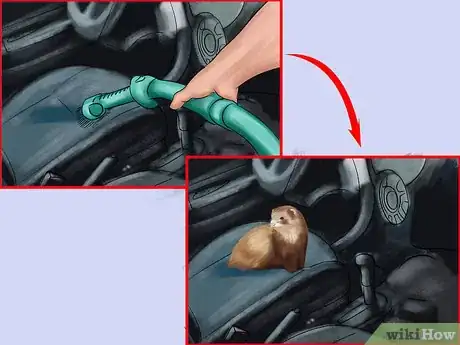This article was co-authored by Pippa Elliott, MRCVS. Dr. Elliott, BVMS, MRCVS is a veterinarian with over 30 years of experience in veterinary surgery and companion animal practice. She graduated from the University of Glasgow in 1987 with a degree in veterinary medicine and surgery. She has worked at the same animal clinic in her hometown for over 20 years.
There are 11 references cited in this article, which can be found at the bottom of the page.
This article has been viewed 57,561 times.
Traveling with ferrets requires a good amount of preparation and care. If you need to travel by air, your options may be limited. Car travel is recommended but carries its own risks. If you must take your ferret along with you on a longer trip, you'll need to make sure they're up-to-date with medications and vaccinations, and look into possible restrictions on ferrets in the area you'll be traveling to. If the proper precautions are seen to, though, the trip can be enjoyable for both you and your furry companion.
Steps
Getting Ready for Travel
-
1Check state and local regulations. Find out if ferrets are legal at your destination and in the areas you are travelling through. Ferrets are currently illegal in the U.S. states of California, Hawaii, and the District of Columbia. They are also forbidden in New York City and Salt Lake City.[1] To find out if ferrets are legal at your travel destination, contact the Department of Fish and Game, or the Department of Fish and Wildlife in the area, and ask about restricted animals.
-
2Make a visit to the vet. It is important to check that your ferret is disease-free and generally healthy before traveling. It can be difficult to detect disease in ferrets, so a checkup with the veterinarian will be necessary before you leave.[4] Make sure as well that your ferret is up-to-date on vaccines. Ferrets require a series of two initial, then annual distemper virus vaccines, and an annual rabies vaccine.[5] Have your vaccine records on hand while you travel.
- Look up the contact information for a local ferret shelter near your destination as well—they should be able to provide you with names of veterinarians who treat ferrets in the area.
Advertisement -
3Consider microchipping. Since ferrets tend not to return if they escape from their home, having a microchip surgically implanted in them is a simple way to locate them in case they flee. This could be especially helpful when travelling, where frequent transfer in and out of the cage provides chances for escape. Ask your veterinarian about the procedure for having a microchip implanted.[6]
- Ferrets entering the UK require a microchip, in addition to treatment for ticks and tapeworms. If arriving from outside the UK, they may also be subject to a quarantine.[7]
-
4Decide on a mode of travel. It is easiest to travel by car with a ferret. When driving, you can decide when to stop for food, play, and rest. You’ll also be able to control what temperatures your ferret is exposed to. If you need to travel by plane, be sure to check with your airline what their policy is on ferrets. Currently, no airlines allow ferrets to travel in the cabin, though this is subject to change. The only airline that allows ferrets to travel as checked baggage is Pet Air.[8]
- Some airlines accept ferrets to fly as unaccompanied cargo, but this is not recommended because of potentially dangerous temperatures in the hold.[9]
-
5Check the automobile for hazards. It is not recommended that you let your ferret loose in the automobile during a road trip. But if you must, there are several potential hazards that need to be checked for and covered up, including dangerous wiring and other metal under the seats. Foam padding under the seats also needs to be covered or otherwise made inaccessible, since it may be a chewing attraction for your ferret. Finally, be sure to vacuum the car thoroughly to clean up old snack foods or other non-ingestible items that could harm your ferret.
-
6Contact hotels or shelters. If you’ll be staying at a hotel or motel at any point during your trip, plan ahead and reserve locations that accept ferrets. If you’re unable to find a ferret-friendly hotel or motel where you’ll be staying, look up a local animal shelter to see if they accept ferrets for short-term periods.
- Some hotels and motels may charge a fee for allowing the ferret, and you should expect to pay for each night the ferret stays at a shelter as well.
-
7Get a suitable carrier or travel cage. If you are travelling by plane, check with the airline what their requirements are for the carrier. If you are travelling by car, find a travel cage for your ferret. It needs to contain a sleeping area, a place to mount a litter box, a food dish, water bottle, a deep basin (to prevent spillage), and be escape-proof. One option is to use a small dog crate and drill holes in it to mount a hammock, food dish, and litter pan. It's easy to mount a water bottle on the wire door of dog crates.
-
8Pack all the necessities. You will need to bring plenty of food, toys, treats, a harness and leash, extra litter, and a first aid kit for your ferret. Also take along all medical and registration records, especially any microchip- and vaccine-related papers.[10]
- Have with you a printed photograph of your ferret. If they escape during the trip, you’ll then be able to make a “missing ferret” flyer.
-
9Let them get used to the cage. For a couple of days before the trip, let your ferret play in the carrier and sleep in it overnight. This will allow them to get used to their new temporary living quarters, and reduce the stress they may feel while traveling.
Ensuring a Safe Trip
-
1Secure the cage in your car. Make sure that the cage is well stabilized in your car, and not likely to shift around or tip over. Strapping the cage to a seat belt can keep it from falling onto the floor area.[11] If the cage is small enough to fit in the floor areas, either in the back or front seats, try putting the cage there if it fits snugly.
- Even if you’re only driving to the airport, make sure your ferret is well secured the same way you would for a long-distance trip.
- If you’re having your ferret flown to a destination with Pet Air, a pickup and dropoff service is available.[12]
-
2Maintain a comfortable temperature. Keep your ferret out of direct sunlight in your car, since ferrets can overheat easily. Never leave your ferret alone in the car during summertime, since they are susceptible to heatstroke.[13] If you feel warm in the front seat, aim some air conditioning toward the ferret to keep them cool too.[14] If you're travelling by plane, don't allow your ferret to travel in the cargo area during summer months.
- Ferrets’ health is put at serious risk if they’re exposed to temperatures greater than 85° Fahrenheit (29.4° Celsius).[15]
-
3Take plenty of exercise breaks. You may be able to drive for twelve hours straight, but your ferret needs to get out and stretch their legs from time to time. Make a point to stop at a rest area or near a park, harness up, and walk them around for twenty to thirty minutes for every four hours of driving.
Expert Q&A
-
QuestionIs it OK to take your ferret outside?
 Pippa Elliott, MRCVSDr. Elliott, BVMS, MRCVS is a veterinarian with over 30 years of experience in veterinary surgery and companion animal practice. She graduated from the University of Glasgow in 1987 with a degree in veterinary medicine and surgery. She has worked at the same animal clinic in her hometown for over 20 years.
Pippa Elliott, MRCVSDr. Elliott, BVMS, MRCVS is a veterinarian with over 30 years of experience in veterinary surgery and companion animal practice. She graduated from the University of Glasgow in 1987 with a degree in veterinary medicine and surgery. She has worked at the same animal clinic in her hometown for over 20 years.
Veterinarian Ferrets do enjoy time outdoors and, when trained to a harness, they can be taken for 'walks' or outdoor excursions. However, be aware they are prone to infection with distemper virus, so talk to your vet first about vaccinating against distemper so as to protect the ferret's health.
Ferrets do enjoy time outdoors and, when trained to a harness, they can be taken for 'walks' or outdoor excursions. However, be aware they are prone to infection with distemper virus, so talk to your vet first about vaccinating against distemper so as to protect the ferret's health. -
QuestionDo ferrets like other animals?
 Pippa Elliott, MRCVSDr. Elliott, BVMS, MRCVS is a veterinarian with over 30 years of experience in veterinary surgery and companion animal practice. She graduated from the University of Glasgow in 1987 with a degree in veterinary medicine and surgery. She has worked at the same animal clinic in her hometown for over 20 years.
Pippa Elliott, MRCVSDr. Elliott, BVMS, MRCVS is a veterinarian with over 30 years of experience in veterinary surgery and companion animal practice. She graduated from the University of Glasgow in 1987 with a degree in veterinary medicine and surgery. She has worked at the same animal clinic in her hometown for over 20 years.
Veterinarian Ferrets are a prey species and have a strong instinct to hunt creatures smaller than them. They may also bite if they feel threatened by a larger animal. Whilst it's not impossible to integrate a well-adjusted ferret to live with other pets, it is by no means guaranteed and for the majority isn't a good idea.
Ferrets are a prey species and have a strong instinct to hunt creatures smaller than them. They may also bite if they feel threatened by a larger animal. Whilst it's not impossible to integrate a well-adjusted ferret to live with other pets, it is by no means guaranteed and for the majority isn't a good idea.
Warnings
- If you take your ferret to an area where ferrets are restricted, they could be taken away from you and euthanized. Always make sure ferrets are legal in your destination and the areas you will be travelling through.⧼thumbs_response⧽
- Ferrets are masters of escape and concealment. Travel in a car can be fun, but vehicles are mazes of doom for ferrets. Escape onto the open roadway, which can easily prove fatal. They might also become hopelessly lodged in the seats or dashboard, requiring costly rescues. No matter the mode of travel, make sure your ferret is fully secure.⧼thumbs_response⧽
- Many people are afraid of ferrets, so consider the possible consequences of travel with an animal that might be mistaken for a cute rat.⧼thumbs_response⧽
Things You'll Need
- Records of Vaccinations
- Travel cage and/or airline-approved carrier or cat carrier
- Food
- Water
- Mountable food dish
- Toys
- Treats
- Harness and leash
- Mountable litter box
- Litter
- Hammock
- First aid kit
- Your veterinarian’s phone number
- Phone numbers for ferret vets near all places you will be on your trip
References
- ↑ http://www.ferret.org/pdfs/general/2009-StateByState.pdf
- ↑ https://www.vetbabble.com/small-pets/ferrets/travelling-with-ferrets/
- ↑ http://webarchive.nationalarchives.gov.uk/20130822084033/http://www.defra.gov.uk/animalh/quarantine/pets/ferretpets.htm
- ↑ https://www.vetbabble.com/small-pets/ferrets/travelling-with-ferrets/
- ↑ http://www.ferret.org/read/vaccinations.html
- ↑ http://weaselwords.com/ferret-articles/traveling-with-your-ferret/
- ↑ http://webarchive.nationalarchives.gov.uk/20130822084033/http://www.defra.gov.uk/animalh/quarantine/pets/ferretpets.htm
- ↑ http://www.flypets.com/
- ↑ http://www.cypresskeep.com/Ferretfiles/Transport-PPN.htm
- ↑ http://weaselwords.com/ferret-articles/traveling-with-your-ferret/
- ↑ http://www.cypresskeep.com/Ferretfiles/Car.htm
- ↑ http://www.flypets.com/services.asp
- ↑ https://www.vetbabble.com/small-pets/ferrets/travelling-with-ferrets/
- ↑ http://weaselwords.com/ferret-articles/traveling-with-your-ferret/
- ↑ http://www.cypresskeep.com/Ferretfiles/Car.htm
About This Article
To travel with a ferret, first make sure to check the state and local regulations in the areas you're traveling through, since ferrets are currently illegal in some places, including California and New York City. Next, visit your vet to confirm your ferret is healthy before traveling. While there, you might want to also consider microchipping your ferret, especially if you want to take it to the UK, where microchipping is required. Finally, purchase a travel cage with a deep basin to prevent spillage, and make sure it contains a sleeping area, litter box, food dish, and water bottle. For more tips from our Veterinary co-author, like how to safely travel by car with a ferret, read on.







































































